The years of 1646-1651 saw a series of armed conflicts between the supporters of the monarchy which was lead by King Charles II who had been declared King after his father King Charles I had been beheaded. King Charles wanted to continue the expansion of power of the Stuart monarchy over Parliament.
 |
| King Charles II |
 |
| Oliver Cromwell |
 |
| Cromwell at the Battle of Worcester |
The prisoners were taken to London where it was noted that most of them had no shoes or little clothing. John could have been executed, but an Act of Parliament in October 1651 instead, had 8000 prisoners sent at their own expense to New England, Virginia or the West Indies. Two weeks later, 272 men were put onboard the "John and Sara" and sailed to New England. John Woodall's name appears on this list of prisoners.
Upon his arrival in New England in 1651, John and his fellow prisoners were sold. John was "bought" by Samuel Richardson, an original proprietor of Woburn, Massachusetts. Samuel died in 1658 and the inventory of his estate included "for service of servants their time to come... Item, John Wattles, five pounds.' After Cromwell's death in the same year of 1658, his son Richard Cormwell was declared to be protector, but he was removed by the Army after 7 months. Eventually monarchy was restored and King Charles II returned to England in 1660. Despite the return of the monarchy he had fought for in 1651, John did not return to his native homeland of Scotland.
John in December 1666 at about age 36, married Mary Gould and settled in Chelmsford, Massachusetts. There they had three known children, a son, William and two daughters, Rose and Mary. John was a farmer or husbandman as term was then used for his occupation. Unfornately within ten years, the period of time in the colonies saw the uprising of the natvive people against the growing number of Colonists. So began King Philip's War which was lead by a Wampanoag leader who took the English title of King Philip. The town of Chlemsford came under several attacks and John was killed in one of them between February and April 1676. His wife and children escaped to the safe harbor of Dorchester, Massachusetts. After the war, his family recieved 16 shilling and eight pence for his death. I
John's descendants would continue on in the Colonies and play an important role in colonial history. Abigail Belcher, the wife of his son William Wattles, was the daughter of Samuel Belcher, the original owner of the house in Braintree, Massachusetts, now [2019] owned by the National Park Service, where the future President John Adams and his wife Abigail, lived and where President John Quincy Adams was born. William Wattles being our direct ancestor.
 |
| Adams Homesteads in Massachsuetts |
John’s grandson, Captain John Wattles, another ancestor in our line, married Judith Fitch, a descendant of Rev. James Fitch, the founder of Lebanon, Connecticut, as well as Major John Mason, Deputy Governor of Connecticut Colony, once renowned and now notorious for conducting the near-extermination of the Pequot Tribe, and also Rev. Robert Peck, a nonconformist during the reigns of James I and Charles I and the leader of the Puritan emigrants who established Hingham, Massachusetts.
From there, our line departs with the marriage of Zerviah Wattles to Israel Damon and the family moving to Wiscassett, Maine and their descendants moving north to Piscataquis County and marrying into our Woodward line of ancestry.
John Wattles, a Scottish Prisoner of War, who came to America, not by choice but by force, would survive a War and battle in his own country which involved thousands, only to be killed in an attack by group in a much smaller numbers and die at only age 46 years.
Any of my cousins on my Mom's maternal side can join the Scottish Prisoner of War Society or join their facebook page as well which has a lot of the information I found on John Wattles.



